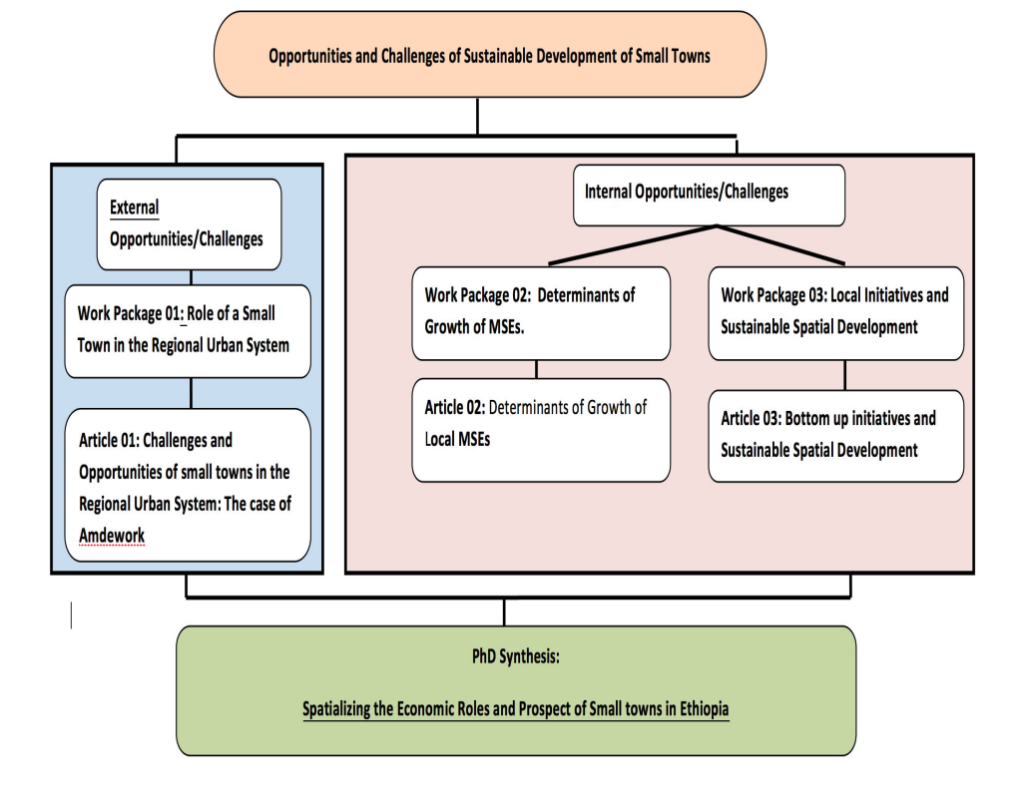Teshome Tefera
PhD Student
Collaboration: Ahmed Z. Khan (supervisor, ULB), Fisseha Weggayehu (Addis Ababa University, Ethiopia), Philippe Bouillard (ULB), Marek Hudon (Solvay Business School, ULB), Luisa Moretto (La Cambre-Horta, ULB)
Spatializing the Economic Roles and Prospects of Small Towns in Ethiopia: The Case of Amdework.
In Ethiopia, a small town is a town with a population of between 2,000 and 20,000. These small towns are important areas of intervention for poverty reduction because they are markets for the rural products, centers of distribution and production places and they are also places for non-farm employment. The small towns are also important because urbanization in Ethiopia is still at its infancy as only 19 percent is currently urbanized and 88 percent of the urban centers in the nation are small towns. It is, therefore, worth investigating the factors that affect the development of small towns in Ethiopia.
The major goal of this research is, therefore, to investigate those factors that affect the economic development small towns through examining the surrounding urban systems in which they operate, their internal structures like local capacities and other bottom up initiatives that have an impact on sustainable development. Three fundamental questions should be answered to achieve the above stated broad objective. These questions are: Who are the major economic actors in the small town and in its relationship in the regional urban system; What factors affect the growth of small businesses in these small towns? and, What bottom up initiatives are there in helping the town develop sustainably and make the economy more circular?
Different authors have forwarded different ideas regarding the factors that affect the development of small towns. Some of them which are frequently raised in different literatures are:
– The leakage of wealth from the small town to the bigger urban centre in the region
– Inability to plan beyond the boundaries of these small towns
– Inability to study and recognize the role of informal bottom up actors and businesses that have an impact on the lives of the residents in these small towns.
– The unhealthy relationship between small towns and big firms
– The inability of small towns to hook themselves to relatively bigger cities with bigger economy that small towns may benefit from.
Hence one can see from these concepts that some of the potential for the development of small towns resides both in the internal facts like the informal bottom up initiatives and small businesses and in the external factors such as their position in and relationship with the regional urban system and policy.
The Overall research Framework and Methodology: The whole study is divided into three work packages as shown in the following diagram. The firsts work package will be descriptive which employs value chain analysis and mapping to study how the case town is related to other urban centers in the region. The second work package on the other hand will use a mix of an inferential statistics, econometric model, and descriptive method to identify those factors that affect the growth of small businesses that characterize small towns. And finally, the third work package will investigate other bottom up initiatives and their impact on making the economy more circular; hence sustainable using descriptive method.

This research is funded by The Jacques Lewin – Inès Henriques de Castro Fund and the ULB for for students from developing countries
Key references
1. Ishii, Satoshi and Maricor Muzones (2013). Low-Carbon Development in Small and Medium-Sized Cities in the People’s Republic of China: Challenges and Opportunities. ADB Briefs, No 14, June 2013. Asian Development Bank. Metro Manila, Philippines.
2. Kwiatek, Agnieszka (2011). Small towns in Poland – barriers and factors of growth. Procedia Social and Behavioral Sciences 19 (2011) 363–370. The 2nd International Geography Symposium GEOMED2010. doi:10.1016/j.sbspro.2011.05.143
3. Muraya,Petronella W.K. (2006). Urban planning and small- scale enterprises in Nairobi, Kenya. Habitat International 30 (2006) 127 – 143. doi:10.1016/j.habitatint.2004.08.002
4. Preston, Felix (2012). A Global Redesign? Shaping the Circular Economy. Energy, Environment and Resource Governance. Chantam House. Briefing paper. March 2012, EERG BP 2012/02.
5. Tacoli, Cecilia (2004). The Role of Small and Intermediate Urban Centres and Market Towns and the Value of Regional Approaches to Rural Poverty Reduction Policy. OECD DAC POVNET Agriculture and Pro-Poor Growth Task Team, Helsinki Workshop 17-18 June, 2004.
6. Victor, Onyebueke U. and EzeadichieNkeiru Hope (2011). Rural- Urban ‘ Symbiosis ’, community self-help, and the new planning mandate: Evidence from Southeast Nigeria. Habitat International 35 (2011) 350-360. doi: 10.1016/j.habitatint.2010.11.0 05
7. Wessels , Johannes (2012). Rural Small towns: development potential or poverty traps? Making sure place doesn’t take preference over people. Paper Presented at a conference on Strategies to Overcome Poverty and Inequality. Towards Carnegie III. University of Cape Town 3-7 September 2012.